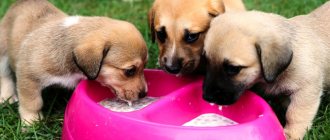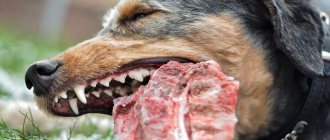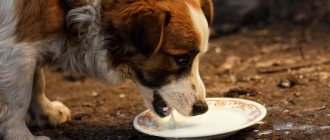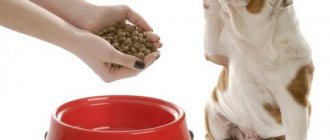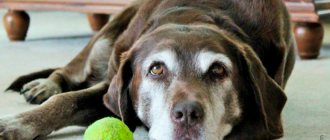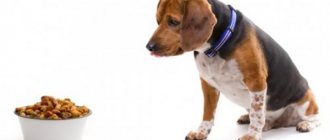Often in houses where both cats and dogs live, the dog quietly eats his neighbor’s dry food. And some owners themselves buy this food for their devoted friends, without thinking whether it is possible to give it to them. But other people’s food is harmful to the animal, and therefore, it is important to understand the reasons for your pet’s love for cat treats and start feeding the dog the right food.
What is the reason why dogs love cat food?
When a cat and a dog live in a house together, the owner begins to notice that the dog pays more attention to the food in the cat’s bowl. She tries to secretly eat the contents of the cup or directly take the food away. What's the matter? Why is this happening?
Dogs, and especially their small representatives (puppies), eat very hastily, as they try to have time to do everything and go everywhere, unlike cats, who like to take their time. At the same time, a dog’s nature is designed in such a way that it seems to it that the food in the next cup is much tastier than its own.
Another reason could be greed. Strong and mature dogs who are accustomed to being leaders in everything are prone to such manifestations. Puppies who were deprived of food by their own mother when they lived with her are prone to this.
Observing the current situation, owners are thinking about whether it is possible to feed their dogs cat food. After all, this will save the family budget, since such food is cheaper. However, the low cost is due to the fact that a large amount of substances are added to this food that enhance its taste, which cats are deprived of. But more expensive and natural products are produced for dogs.
Is it possible to give dogs cat food?
Contents hide
Many dogs enjoy eating from a cat's bowl. The explanation is simple: premium and super-premium cat food contains a lot of protein and fat. A cat's diet should not be dominated by grains, fiber, vegetables, flour and similar ingredients. The ideal daily proportion is 80% meat and 20% plant components. On the contrary, dog food contains a large amount of vegetables and fruits, since dogs need carbohydrates in addition to proteins and fats. An excess of proteins leads to obesity, kidney and vascular diseases. The share of meat in a dog's daily diet should be 30%. In addition, cat food contains several components that are not suitable for feeding dogs. Let's look at the main ones.
Taurine . This is an essential amino acid for cats, which must enter the body with food, so taurine is additionally added to cat food (manufacturers prescribe it as part of the composition). Taurine is necessary for cats to break down fat, normal functioning of the nervous, reproductive, and cardiovascular systems, and maintain optimal blood sugar levels (prevents the development of diabetes).
Dogs do not need taurine, as this amino acid is produced in their bodies. When eating cat food, a dog receives an excess of taurine. This leads to diseases of the kidneys, heart, intestines, and can also cause allergies and problems with the birth of offspring.
Minerals . Cats and dogs need many macro- and microelements from their food. The most significant: iodine, phosphorus, calcium, sodium, magnesium, iron, copper, zinc. Moreover, certain elements are important for each animal. For example, dogs require large quantities of calcium, phosphorus, magnesium, and cats require magnesium, sodium, and iron. The daily dose may vary significantly, especially when comparing a young cat and an adult large dog.
Vitamins . Cats, dogs and people need the same vitamins for normal growth, development, and disease prevention. Some vitamins are produced in the bodies of cats and dogs. Additional dosages are prescribed only for injuries and illnesses to speed up recovery. The dog's body produces vitamins C, D under certain conditions, some from group B, PP in minimal quantities. The cat's body synthesizes vitamins C, D, K. The remaining vitamins must come from food, so cat food contains vitamins B and PP, which are not always required by dogs. At the same time, dogs who adore cat food may develop a deficiency of vitamin K, which is responsible for blood clotting. It should also be taken into account that cats are not able to convert beta-carotene into vitamin A, it must be supplied in ready-made form, therefore cats should not be given food from a dog bowl.
It is also important to note that vitamins C and B are water soluble and are quickly eliminated from the body through urine, so overdose is almost impossible. But vitamins E, A, K, D belong to the fat-soluble class. They accumulate in the body, so they cannot be given just like that or in large quantities - overdoses are possible. An overabundance of vitamins that are beneficial for cats, which manufacturers add to food, can lead to health problems for dogs.
Balanced industrial food is produced taking into account the characteristics of the body of cats and dogs, so feed the animals separately. Nothing bad will happen if the dog eats cat food just once, but if this happens systematically, take action. You can place the cat bowl higher where the dog cannot climb, hide it in a box with a narrow opening so that the dog cannot stick its muzzle in, or buy a special anti-dog bowl for cats.
Photo source: unsplash. com
Why is cheap cat food harmful?
Sometimes a dog may steal food from a cat because its food is richer in proteins. Manufacturers of expensive cat products take this into account. After all, animals really need this substance.
Cheap dog food is inferior to good cat food. Therefore, animals can feel it and be drawn to it accordingly.
But what happens to dogs if they constantly eat an inexpensive product? Why is cat food bad for dogs?
The strong aromatic smell of economical varieties attracts animals, which subsequently, like cats, become attached to it and begin to refuse other usual food.
Can dogs be given cat food: how can it be dangerous?
It is quite difficult to answer this question unequivocally, since the body of animals reacts differently. However, some veterinarians argue that for representatives of small breeds of dogs such food can be truly dangerous.
Cat food contains a lot of protein. This component in large quantities is very dangerous for dogs, especially puppies. Protein negatively affects the functioning of the liver and also impairs the functioning of the digestive system. This component leads to the appearance of diseases associated with the performance of the heart or kidneys. In some cases, allergic reactions appear in the form of redness on the pet’s body. Other signs of excess protein include:
- strong mobility;
- nervousness;
- constipation.
Obesity is one of the consequences of regular consumption of cat food.
Also, cat food contains a lot of fat, which causes obesity and pancreatitis in dogs.
Food for dogs and cats contains different vitamins, which also negatively affects the functioning of organs. For example, cat food contains virtually no magnesium, which dogs need.
Additional Information. If you often feed dogs cat treats, the animals will develop gastritis or even ulcers. These diseases can occur due to the fact that cat food contains taurine in large quantities.
How to teach your pet to eat properly
To wean your dog off cat food you need to show persistence, patience and imagination.
Feed the cat in places out of reach of the dog, for example, on a windowsill. Outsmart your stubborn dog by putting dog food in your cat's bowl.
Find the dog food that is best for your pet. Quality products fall into the premium and super premium categories. In addition, they are divided by category (age, breed, health status).
What types of dog food are there?
The question of whether it is possible to feed a dog cat food, which arose as a result of the dog’s attachment to it, will disappear if you try to understand proper dog nutrition. At the same time, it is worth choosing the best diet for your pet.
There are 4 types of dog food:
- Dry food. The best option for all homeowners. It is not expensive, stores well, has a neutral odor, has brown tints and contains a minimal amount of water.
- Semi-moist food. Every dog loves this treat. It resembles meat gravy. It is packaged in sachets or jars. It costs a little more than dry food. Average dog owners can afford it.
- Pates or wet food. They are expensive, and not every citizen can afford them. I release them for puppies or older dogs who already have dental problems.
- A variety of treats for dogs. They are also expensive, but are not intended for constant consumption. They are used as treats or rewards.
Is it possible or not for a puppy to eat cat food?
Are you also wondering if this is possible or not? The answer is clear - dogs should not be given cat food!
Let us immediately note that the gastronomic needs of cats and dogs are very different:
- Cats are exceptional carnivores, which means that meat products predominate in their diet. It is important to understand that this is not a whim, but a necessity, without which the cat will get sick, lose weight and develop poorly.
- Dogs, contrary to popular belief, are omnivores and require a more varied diet.
Many inexperienced owners start feeding their dog only meat, trying to do the best. Literally within a week or two, the dog goes into toxic shock! During the breakdown of proteins, toxins are produced in the pet's body, from which it cannot and does not have time to cleanse itself.
Industrial products for cats should contain more protein than for dogs, at least when it comes to quality food.
Interesting! Veterinarians suggest that puppies are attracted to cat food due to its high protein content.
During periods of active growth, even with high-quality feeding, the puppy may experience insatiable hunger. However, the owner must behave reasonably and understand that not everything the puppy wants to eat can be given to him.
Is it possible to feed?
Why is it still not recommended to mix up feed even in small portions? The most common health problems due to poor eating habits:
- allergy;
- pancreatitis;
- otitis, fungal ear infections caused by weakened immunity;
- skin diseases seborrhea, fungus;
- coat problems: dull, falling out, tangled;
- eye diseases: conjunctivitis, blurred vision, early onset of blindness;
- obesity;
- stool loss, other digestive problems;
- hormonal imbalances;
- behavioral disorders;
- lethargy;
- kidney and urinary tract diseases;
- liver problems.
Differences in chemical composition:
- Too much protein. Protein, protein for a cat is the basis of nutrition. Therefore, her diet is much richer in these substances. Dry food compensates for the lack of protein. Daily consumption of this amount of microelement, even in puppies, disrupts the functioning of the pancreas and liver.
- Increased amount of fat. A cat needs slightly more fats, so they are present in food in higher volumes. The “cat” norm threatens the dog’s body with metabolic disorders, including obesity.
- Low carbohydrate content. Carbohydrates are a source of energy, strength, and excellent mood. The right carbohydrates help the puppy develop well and keep the old man in excellent physical shape. The quantity cannot be exceeded, but there should not be a shortage. Even the body of the most active cat does not require a large amount of this element, so its food does not contain enough carbohydrates for a dog’s body. A lack of carbohydrates means lethargy, apathy, and problems with the nervous system.
- High levels of taurine. Taurine and arginine are amino acids. The cat's body does not produce taurine at all, but the dog's gallbladder can partially compensate for its deficiency. Accordingly, an excessive amount of taurine enters the dog’s body with someone else’s food. This contributes to exhaustion of the nervous system, vision problems, and kidney failure.
- Imbalance of vitamins. If a puppy or an adult regularly eats only cat food, a lack of vitamins A, H, as well as an excess of vitamins E, B, zinc will affect the condition of the skin, coat, the functioning of the digestive system, in some cases – kidney and liver damage, skeletal deformities. The body is weakened, immunity decreases.
If the dog accidentally eats the rest of the portion from the cat’s bowl, there is no need to sound the alarm. The main thing is to avoid systematic confusion with the nutrition of pets.
Important: the strict rule not to mix products applies to both dry and wet food.
The exception is universal meat pieces - canned food created for pets. This is ordinary meat, prepared according to the rules for feeding animals: with water, without oil, salt, pepper, or additives. Typically this product is used if animals are on a natural diet. However, it is not recommended to provide additional specialized food.
Why is cat food harmful to dogs?
As already mentioned, canines and cats need different vitamin sets.
Cat food is bad for dogs for a number of reasons:
- Increased protein content. Dry dog food contains 15-25% protein, cat food - 40-70%. The difference is obvious. The dog will put a strain on his liver and will rapidly gain weight. Cats need high-calorie nutrition, and manufacturers take this into account. Dogs readily eat cat food due to its high protein content. It seems more tasty to them.
- Increased acidity. It negatively affects the functioning of the pancreas and causes heartburn.
- Different vitamin and mineral composition. Cat foods contain more vitamin B than dogs need. The same goes for protein. Its excess provokes diseases of the eyes and ears, as well as skin rashes.
- Lack of fiber. This substance stimulates the digestion of dogs, but is of no use to cats. Low fiber content causes constipation or, conversely, diarrhea.
- Reduced levels of vitamin E. Dogs need it to maintain immunity. Vitamin E deficiency will reduce the body's resistance.
- Low carbohydrate content. Despite the high levels of protein and fat, cat food does not contain enough carbohydrates. Dogs cannot replenish their energy reserves and look sleepy and tired.
Of course, you can’t become poisoned by food all at once. A dog can eat it without consequences for six months. However, there are cases of immediate reaction. The dog begins to vomit, have an upset stomach, and develop a rash. At risk are “allergic” dogs, toy breeds, elderly dogs, lactating dogs and those undergoing a recovery period.
Many owners use cat food as a treat or reward. There is no need for this. The modern pet industry produces a lot of dog treats. You should not expose your pet to even minimal risk.
Dog food classes
Products are divided into classes depending on quality and cost. Dog food is divided into:
- Economy class. These products are most often advertised, but they are not that safe for animals. In the composition you can see corn and legume ingredients, a large number of plant components, and animal proteins. The granules are painted in a variety of bright colors. In addition, the products contain salt.
- Premium class. These are, so to speak, popular varieties of dog food. They are all fortified and suitable for complete feeding of healthy pets.
- Holistic class. This is the best food. This variety does not contain salt, but has a small amount of preservatives. The food has a natural base.
- Medicinal feed. They are used only with the permission of a veterinarian.
- Special food for pregnant or weakened dogs.
Why dogs love cat food
Dogs of many breeds are cheerful, energetic, and active. Unlike leisurely graceful cats, they eat their portion in a matter of minutes. Curiosity makes them stick their nose into the cat's bowl, and their larger size makes them push the cat away and finish his food.
Leader dogs are distinguished by greed, which turns into food aggression. They do not allow anyone near the bowl from which they eat (even if the food is someone else's). Another reason for gluttony is weakness and malnutrition in puppyhood.
The dog will be happy to eat economy-class cat food, which has added flavorings and taste enhancers. Such food is harmful for any pets, since its production uses cheap, low-quality ingredients.
Composition of dry and wet
As mentioned above, cats consume fish, so fish, salts and salted meat are added to dry cat food. The amount of protein in them is quite high, and there is practically no fat . Canned food contains a small amount of vegetables, as well as a thick broth.
Dry dog food contains poultry, rabbit and beef. Protein and fat are in approximately equal proportions. Canned food is made from animal meat, sometimes crackers or pieces of meat jelly are added.
The dangers of feeding your dog cat food
It is not recommended to feed your dog cat food. Of course, nothing will happen just once, but if a puppy regularly eats several grams of cat food for six months, his body reacts aggressively to the content of harmful microelements and the lack of essential vitamins, including vitamin E.
In addition to disruption of the dog’s digestive system, the pet may develop problems with the liver, kidneys, and musculoskeletal system.
1. A pet may have an allergic reaction to the increased protein content in cat food. In addition, the food becomes very high in calories, so the dog may become obese.
2. Otitis and asthma, purulent rashes, ulcers on the pet’s skin indicate the development of a serious disease leading to death due to a simple allergy.
3. The dog may suffer from heartburn and indigestion, since cat food is usually specially acidified.
4. The four-legged friend begins to gain weight quickly from cat food, which is due to the high calorie content of the food. In addition to obesity, a liver disease called hepatosis may develop.
5. The dog’s immunity decreases, since cat food does not contain vitamin E, as well as zinc, which is very necessary for any small or large puppy.
6. The dog becomes tired and inactive, which is observed due to the reduced carbohydrate content in the food. Usually, food is produced for cats that is rich in proteins and fats, but carbohydrates are not needed for affectionate pussies.
7. Many dogs begin to suffer from diarrhea or, on the contrary, constipation simply because they have consumed cat food, which contains practically no fiber, which is necessary for comfortable digestion of food.
Thus, you should not feed your four-legged friend cat food, otherwise serious health problems may arise for the dog.
How are foods differentiated based on dog age?
There are also feeds:
- Food for puppies from 2 weeks to 2 months.
- For dogs and puppies from 2 months to 10 months.
- For dogs from one to 8 years old.
- And for dogs over 6 years old.
There are special foods for dogs from 6 to 7 years old. When choosing, it is worth considering some nuances. You should not feed an adult dog puppy food. Before choosing a particular product, it is advisable to consult a veterinarian.
In addition, on each food package you can find information about the required feeding doses for each specific weight of the pet, and special dietary formulations are being developed for dogs prone to obesity.
Is cat food harmful to dogs and why?
What will happen to the dog if you constantly feed it cat food? Despite the fact that these representatives of the animal world are predators, their lives develop differently.
Their blood composition is different, as well as the amount of protein and glucose is different. Cats like to eat several times a day, but little by little, and dogs can eat both 2 and 1 time a day and will not feel much discomfort.
What's unusual is that large dogs can go a long time without eating, as they lie around a lot and are lazy, thereby saving energy. While a small individual requires more food intake.
When asking yourself whether you can give your dog cat food, remember that cats need taurine. Dogs don't need it. Their body synthesizes it independently. Therefore, a large intake of such a substance from cat food can lead to heart failure in a dog.
At the same time, the taurine included in the food suggests the presence of a large amount of protein in combination with amino acids.
Is it possible to feed a dog cat food?
Animals not only differ in behavior and lifestyle, but also in blood composition, need for proteins, glucose and other elements.
What happens if you feed your dog cat food?
- The dog’s body produces taurine on its own and does not require it from food. Eating a cat diet that additionally uses this substance can cause heart failure. The heart muscle weakens and blood circulation slows down.
- The high level of protein in cat food keeps the cat's acidity elevated by dog standards. Eating it regularly will lead to gastritis or even stomach ulcers.
- A cheap diet can cause an allergic reaction to harmful components. Hair will begin to fall out, lacrimation and intestinal disorders will appear. Some toy dogs are at risk of allergic shock.
- Lack of fiber will cause severe complications in the digestive tract. Dietary fiber promotes digestion and stimulates peristalsis. The accumulation of feces causes intestinal injuries and general poisoning of the body.
- Due to excess protein, seborrhea, otitis media, conjunctivitis and dermatitis occur.
- A lack of vitamin E and zinc for dogs has a negative impact on the overall immune system. Metabolism is disrupted, which leads to poor absorption of carbohydrates and healthy fats.
- Systematic abuse of cheap cat diets leads to kidney failure. Neutered and small breed dogs develop urolithiasis in a short time.
But if a situation arises when dog food is not available at the right time, is it possible to give the dog cat food? A small amount of the “wrong” diet will not cause much harm. But you need to choose based on the following factors:
- Soy, flour and other cheap ingredients are not the best option. It would be better to spend money on a premium pack than to endanger your pet’s health.
- Avoid fish and salts.
- The amount of protein should be no more than 20%.
- Food containing taurine should be given with caution. It suppresses external allergic symptoms, while internal ones proceed with full force.
Monitor the condition of the feces and the well-being of your pet carefully. If there is the slightest change in a negative direction, immediately stop feeding this product. If the condition does not return to normal within a day, take your dog to the veterinarian for a consultation.
Is it possible for dogs?
Everything is individual and situational. Cat food contains a lot of protein, which can slow down your dog's digestion process. But if your pet is active, then his body needs just this amount of protein. Another question is whether the dog’s body can digest fish and salty foods?
REFERENCE! We often hear that if a dog eats something, then its body needs it. Let's remember that dogs eat out of garbage cans out of curiosity. Like all animals, they explore the world around them and try something new. This factor is inherent in all living beings; it can solve the problem of lack of food in difficult times.
In other words, if a dog tasted trash food during a period of famine and concluded that it helped it survive, this information will be passed on to future generations, continuing the family line and increasing the chances of interspecific competition.
If your pet has consumed cat food once, it may cause minor changes in digestion, but will not lead to serious problems.
In cases of systematic use, the gastrointestinal tract will sooner or later adapt to digesting these products.
But this does not always happen, keep an eye on your pet’s feces and condition; if you notice that his behavior and well-being have changed for the worse, you need to stop feeding him cat food and take him to a veterinary clinic.
If there is no other
If you are standing in front of a shelf where only cat food remains, then choose based on the following factors:
- Lack of cheap ingredients (soy, flour, vegetable by-products).
- Look at the price. It is better to take a small package of premium quality so as not to risk your pet’s health.
- They also produce meat food and various assorted food for cats. Choose food without fish or salt.
- Pay attention to the amount of protein, it should not exceed 15-20 grams per 100 grams of dry product.
- If it contains taurine, such food can be given, but in smaller quantities, since taurine is produced by the dog’s body and has a feedback mechanism with histamine. The more taurine, the less histamine. This means that in the event of an allergy, external signs (scabies, rash, hair loss) will not appear, but the internal ones will occur in full. This is dangerous because it can lead a latent disease to an advanced stage, which will be more difficult to cure.
What will be the consequences for the health of the dog's internal organs?
If your dog regularly consumes cat food, he will invariably develop health problems. Poor nutrition primarily affects the internal organs. Feeding your pet cat food? Then get ready for the following consequences:
- Cat food contains taurine. Its high consumption causes heart failure in dogs.
- Cat food is high in protein, which is needed to maintain acidity. Dogs do not need this type of food because the food's too acidic environment is harmful to their digestive tract. As a result, regularly eating canned cat food causes heartburn and vomiting in the dog. And subsequently the pet develops gastritis and stomach ulcers.
- For small breed dogs, as well as for puppies, it is not advisable to consume dry cat food. Because this causes urolithiasis and kidney failure.
- Cat food is strictly contraindicated for decorative breed dogs. Because they need specialized nutrition. Even if a purebred dog tries cat food just once, it can cause allergic shock and, as a result, death from suffocation.
- Cat food has a high protein content. And high consumption of protein foods causes chronic liver inflammation and obesity in dogs. As a result, the pet loses its appetite and suffers from constipation and diarrhea. He may develop abdominal dropsy.
What diseases can cat food cause in dogs?
Veterinarians know very well whether it is possible to give a dog cat food. By reading their reviews or talking in person, you will definitely answer this question.
Protein is very important for cats. It is he who helps them maintain normal acidity of the digestive tract. While for dogs, on the contrary, it increases this acidity. Therefore, dogs that regularly eat food intended for cats suffer from heartburn, stomach ulcers and gastritis.
In addition, after frequent consumption of such a product, animals may become ill:
- seborrhea;
- conjunctivitis;
- dermatitis;
- otitis media
Kidney failure occurs in dogs that consume economy-class cat food for a long time, and small and sterilized dogs suffer from urolithiasis. The animal may also suffer from constipation and indigestion. Due to a lack of vitamin E in cat food, your pet will have a weakened immune system.
Decorative small dogs can be susceptible to suffocation and allergic shock. This often leads to death.
Is it possible to give a dog soft cat food? No, because it also contains a lot of protein. It is simply necessary for cats.
Why cat food is bad for dogs
If a dog regularly eats food from a cat's bowl, this can lead not only to disruption of the digestive system of a four-legged pet, but also to more serious problems, for example, diseases of the liver, kidneys or musculoskeletal system.
- The high protein content in cat food can cause allergies in your dog. Symptoms of an allergic reaction manifest themselves in different ways: from purulent ulcers and skin rashes to otitis media and asthma. Small toy breeds of dogs are especially susceptible to protein allergies.
- Due to the fact that cat food is acidified, dogs after such a diet may suffer from heartburn and indigestion .
- Food made specifically for cats is very high in calories and its abuse leads to dogs quickly gaining excess weight, which can even lead to obesity.
- Due to a lack of vitamin E and zinc in a cat's diet, the dog's immunity decreases , making him vulnerable to various types of diseases.
- Cat food is high in fat and protein and has virtually no carbohydrates. But dogs get energy from carbohydrates , and if there are few of them, the animal quickly gets tired and becomes lethargic and apathetic.
- Cat food contains little fiber, which dogs need for normal digestion. As a result, such a diet will lead to the four-legged pet suffering from diarrhea or constipation .
If your dog regularly eats cat food, it will cause digestive problems.
Do not forget that the body of older dogs, pregnant females and small puppies reacts especially acutely to low-quality or incorrectly selected food. Therefore, the nutrition of such pets should be approached with all responsibility and remember that under no circumstances should they be fed cat food.
Can dogs eat cat food sometimes?
Of course, if a dog occasionally eats from a cat’s bowl, there will be no irreparable harm to his health . But if the owner frivolously allows the dog to regularly consume such food, then such carelessness will lead to the development of various diseases in the animal and in this case it is impossible to do without the help of a veterinarian.
If the dog has eaten cat food a couple of times, there will be no harm.
How to stop a dog from eating cat food?
Despite the fact that your dog loves this treat, it is necessary to wean him off it. What should be done?
No matter how much you love your dog, remember that no pet has ever said goodbye to this world with a bowl full of food. If you offer her other food, she will soon begin to try it. But you need to remember a few rules when transferring your pet to another diet:
- The dog should not be allowed to overeat.
- Feed your cat and dog separately.
- Never give cat food.
- Don't skimp on treats.
- Do not give cold and tasteless food.
- If it's dog food, it shouldn't be of good quality.
- Do more physical activity with your dog, so it will become more hungry and will eat what is offered.
- Be sure to visit a veterinarian and find out everything about your dog's health.
You can wean off cat food gradually, that is, mix it with other food, but reduce the dosage every day.
If you care about your pet, then ask yourself: is it possible to give your dog cat food? Think about the fact that she is also a living being and is not immune from all kinds of diseases.
Why can't you feed your dog cat food?
So, what happens if you give your dogs cat food? In the process of development, cats and dogs occupied different niches in the natural chain. Yes, both species are carnivorous predators, but their lifestyle and metabolism are very different. Cats and dogs have different blood compositions, different levels of glucose, protein and other substances.
Purrs eat little but often, which helps maintain high blood sugar levels. Most dogs are adapted to one or two meals a day and do not experience discomfort from this. Surprisingly, the larger the dog, the longer it can live without food, this is explained by instinctive conservation of energy, which can be perceived as laziness.
Cats need taurine and food manufacturers take this into account. The dog's body synthesizes taurine and does not need it from the outside. Supplemental taurine consumed regularly by dogs is a cause of heart failure, most commonly cardiomyopathy.
Note! Taurine itself is clearly included in the composition of cat food; its presence is implied by the increased content of protein in combination with amino acids.
The increased proportion of protein helps cats maintain the normal acidity of the digestive tract, which is high for dogs. That is, cat food regularly eaten by a dog can cause heartburn, gastritis and ulcers.
Does a cat need fat?
Owners are wary of fat in their cat’s diet, especially if the cat is prone to obesity. But in reality, fat alone will not make a predator fat, just as greens do not make herbivores green. An animal gains excess weight not because of specific macronutrients, but because the total caloric content of the diet is exceeded. If a high-fat food contains a minimum of carbohydrates and is dosed correctly, the cat will be in excellent shape.
Domestic dogs have partly adapted to extract energy from carbohydrates, so dog foods sometimes contain less animal fat and more grains. By consuming such a product regularly, cats will receive less of the essential arachidonic acid, which affects the health of the reproductive, gastrointestinal and other systems. In addition, vitamin A (retinol) is fat-soluble, and if it is not fully absorbed by the cat’s body, it will lead to decreased vision, hair loss, and in the case of kittens, growth retardation.

